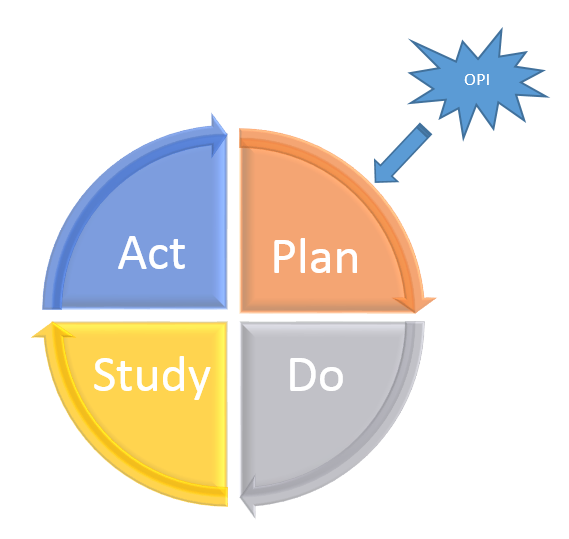One of the most basic foundations of Lean is the PDSA cycle, which guides virtually all improvement approaches. Dr. Edwards Deming is credited with developing the Plan-Do-Study-Act (PDSA) cycle of continuous quality improvement based on his learning from Walter Shewhart at Bell Labs. The cycle is also know as Plan-Do-Check-Act (PDCA), the Shewhart cycle, or the Deming Wheel. It’s based on the scientific method:
1) Form a question
2) Make a hypothesis
3) Predict the outcome
4)Conduct a test or experiment
5) Analysis the results
(Repeat steps 2-5 as needed)
The PDSA cycle begins with an opportunity for process improvement (OPI). This is a problem, an error, or an area you’ve identified as needing improvement.
In the planning phase, clearly identify the problem, develop an understanding of what the future state should look like (once the problem has been removed), and conduct a root cause analysis to determine the likely cause or causes of the problem.
Once the likely root cause or causes have been identified, identify solutions or countermeasures that can be tested. (Lean prefers the term “countermeasure” over “solution” because most systems and processes are complex enough that there is rarely a solution; instead, countermeasures to likely causes of problems are put in place to bring about success. In addition, thinking about countermeasures as opposed to solutions encourages a mindset of continuous improvements to a process rather than a goal to reach and then forget about.)
DO
In the do phase of the cycle, test out the proposed countermeasures. It’s usually best to try solutions in a limited area, such as one neighborhood or department, so you can make modifications or adjustments before rolling it out to the whole community.
STUDY
After implementing countermeasures, collect data and analyze the results of the pilot tests. Were the countermeasures effective? Is the problem better? Worse? The same? Different changes can require different timelines for checking on their effectiveness, but generally 30, 60 and 90 day marks provide a good place to check on the status of countermeasures.
ACT
If countermeasures were found to be effective, incorporate any improvements or learning from the pilot and roll out the countermeasures to other appropriate areas. If the pilot didn’t produce the desired result, begin the cycle again. Perhaps a root cause was incorrect or missing? The implementation wasn’t complete? Area staff weren’t involved effectively?
The key to the PDSA cycle is to work methodically through challenges, experiment with and evaluate changes, and act on the results.
PDSA is the basis for A3 thinking, a tool that grounds the improvement cycle in an easier to understand and follow process. By working through problems and their causes in a scientific, methodical way, we can develop effective countermeasures and build on prior success.


